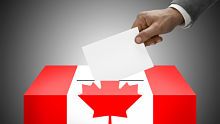
In the aftermath a majority election win by the federal Liberals, economists with the major Canadian banks have begun to sift through the new government’s fiscal plan, looking for the likely impact to the Canadian economy.
Economists believe that Liberal plans to run modest deficits, in order to pay for infrastructure and other program spending, should not de-rail Canada’s fiscal strength over the short term, and could boost economic growth. However, much is contingent in how the government implements its plan, and whether it shows the discipline to rein in spending three or four years down the line.
Here’s what bank economists are saying:
> Deficit and debt
The new government’s spending plans, should they proceed, involve running a budget deficit of about $10 billion annually over the next two years, with half the spending to fund infrastructure, and the other half to fund campaign promises in areas such health care, job training, the environment, and others.
Economists with the big banks point out that deficits under the Liberals may turn out to be somewhat larger than the new government forecasts, particularly if economic growth projections used by the party in its fiscal plan prove too optimistic, as some economists believe. Nevertheless, deficits should peak in the range of 0.5%-0.6% of gross domestic product (GDP) under the Liberal fiscal plan.
Federal debt relative to GDP may rise, compared to what it would have been under the previous government’s budget plans. Nevertheless, overall debt will continue to decrease, even with the increased deficit, and is expected to drop to 26.5% of GDP by 2021, down from around 30% now, according to a report from TD Economics published on Tuesday.
“It’s still the lowest level among the G7 major economies,” the authors of the TD Economic’s report suggest.
The chief concern regarding the government running a deficit appears to be whether it will have the discipline to make sure that it sticks to its plan to return to balanced budgets in three or four years, argued the authors of a BMO Capital Markets report: “It’s easy to start spending, but it’s much tougher to unwind that spending,” they said.
> Economic growth
Economists expect the government’s infrastructure spending — depending on if it goes through and how much of it is implemented immediately — to boost economic growth by anywhere from 0.1% to 0.5% in GDP in 2016.
“It’s good news for the Canadian economy, not only because [infrastructure spending] will help GDP growth, but also lift the economy’s potential growth, which had been hindered for years by underinvestment,” said the authors of a post-election economics report released by National Bank Financial Markets.
Consumer spending is expected to decrease if the government goes ahead with plans to expand the Canada Pension Plan, and therefore increase pension contributions, leaving Canadians with less money overall. However, the negative effect of the increased contributions is likely to be offset by the reduction in the middle class tax rate to 20.5%, from 22% currently, even taking into consideration the creation of a new 33% tax bracket for those making $200,000 or more.
“Increasing after-tax incomes at the lower end typically leads to greater consumption and reduced savings, given the higher propensity to spend at lower incomes,” according to a economics report published by the Canadian Imperial Bank of Commerce (CIBC).
> Interest rates and the loonie
Bank economists believe that the added fiscal stimulus of infrastructure and other spending makes it less likely that the Bank of Canada will decide to make a rate cut in the short term, and increases the chance it will start to raise rates sooner than it might have otherwise.
“Our current forecast is for the Bank of Canada to begin raising rates in July 2017, increasing the policy rate to 1.25% (from its current level of 0.5%) by the end of 2017,” wrote the authors of the TD Economics report. “It is possible that with additional infrastructure-led growth, the Bank may choose to begin hiking rates earlier and perhaps more aggressively.”
In turn, the Canadian dollar may receive a boost if the market gets a sense that the Bank of Canada decides to pursue a tighter monetary policy sooner.
Economists, however, remain cautious about the loonie, given the strength of the US dollar, low oil and other commodity prices, economic uncertainty in emerging markets, as well as concern that the government might not able to rein in spending over the long term.
> Equity markets
Despite any lingering concerns over aspects of the Liberal fiscal plan, the markets generally cheered the election of a majority government, economists said.
“Pre-election polling had suggested that a Liberal minority was likely, leading to a risk that market volatility could spike around potential no-confidence votes,” wrote the authors of the TD Economics report. “With a majority government, this risk has been eliminated.”
Spending on infrastructure could benefit equities in the engineering and construction space, suggest the authors of the CIBC report. Meanwhile increased low- and middle-class spending, thanks to redistributive tax cuts and measures, may favour consumer-related equities at the expense of equities that benefit from spending “favoured by high-income earners.”
It was too soon to tell what the effect of a Liberal government would be on the energy sector, given the party’s support of some, but not all, pipeline projects, and the priority it has placed on the reduction of carbon emissions, the CIBC report suggested.